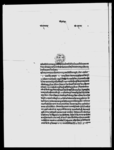A lālamohara from King Rājendra updating a VS 1864 land grant to Bānu Pādhyā Dāhāla (VS 1889)
ID: DNA_0013_0072
Edited and
translated by Rajan Khatiwoda
in collaboration with
Simon Cubelic
Created: 2018-08-11;
Last modified: 2018-11-28
For the metadata of the document, click here
The accompanying edition, translation/synopsis and/or commentary are available under the terms of the Creative Commons Attribution-ShareAlike 4.0 International License
Abstract
This lālamohara issued by King Rājendra reclassifies as birtā, land granted to Bānu Pādhyā Dāhāla by the king’s father on the occasion of the annual death ritual of the king's grandfather in VS 1864 (1807 CE).Diplomatic edition
[1r]
1श्रीदुर्गाज्यू\1श्रीवाज्याज्यू2१1श्री५वुवाज्यू
2२[royal seal]1स्वस्तिश्रीगिरिराजचक्रचूडामणिनरनारायणेत्यादिविविधविरूदावलीविराजमानमा
2नोन्नतश्रीमन्महाराजाधिराजश्रीश्रीश्रीमहाराजराजेन्द्रविक्रमसाहवहादुरसम्सेरजङ्
3देवानांसदासमरविजनियाम्¯ ¯ ¯ ¯ ¯ ¯ ¯ ¯ ¯ ¯ ¯ ¯ ¯ ¯ ¯ ¯ ¯ ¯ ¯ ¯ ¯ ¯
4आगेवानुपाध्यादाहालकेसम्वत१८६४सालमितिवैसाषसुदि७रोज५कादिन
5¯ ¯१¯ ¯कावार्षिकश्राद्धमा¯ ¯२¯ ¯कावाहुलिवाटसंकल्पभयाकाषेतमध्येषेतमुरि
6५०तस्कोसरहवमोजिमकोघड्यारिस्मेतविर्तागरिवक्स्याकोमोहरताँवापत्रगरिवक्स्यौं
7ठिमिकाअम्वलमध्येदुगाडोलषेतमुरि।३७।१०तस्कोसाँधपूर्वभोलानाथझाकावि
8र्ताकोसाँधलुहुकिलदक्षिणपश्चिमउत्तररैकरकोआलिसाँधलुहुकिलऔलाम
9झाषेतमुरि।१२।१०तस्कोसाँधपूर्वरैकरकोआलिसाँधलुहुकिलदक्षिणवाटाकोढ
10लकोआलिसाँधलुहुकिलपश्चीमउत्तररैकरकोआलिसाँधलुहुकिलऐजन्काअ
11म्वलघड्यारितर्षागालपाषोमुरि।१०तस्कोसाँधपूर्वगंगादत्तअधिकारिकोविर्तासाँ
12धलुहुकिलदछिनपश्चिमउत्तरपाषाकोआलिसाँधलुहुकिलयतिचारकिलाभित्र
13षेतमुरि५०घड्यारिपाषोमुरिदस्१०विर्ताजानिसंतानपर्यन्तपरमसुषभोग्यगरयो
14विर्तासंकल्पहुदासंकल्पवाक्यपह्रन्याप्रोहितयदुनाथपंडीतअर्ज्यालपानिहाल
15न्याकाजिभीमसेनथापासांधलाउन्यासधियारसिवनाभअर्ज्यालभवानिसंकर
16षनालहरिवंसवोहोराडगोलनाईकधनवन्ततल्लाछेटोलकोद्योडोटोलकोज
17गत्व्रह्मटोलकोमहिन्द्रमधुसुदनजैसिदाहाल्ढलपाचिगढिछुंमोहानन्दपं
18न्तसिंगंगाधरअधिकारिगुणाकरपाध्यासापकोटासिधिनारायणजोगापिला
19देविसिंज्यापुजैनर्सिंकुम्हालविलकिसिंज्यापुविर्तवारलेकिलाभन्दाअर्घ्यालोन
20चापनुविनातकसीरजवदनगर्नुजोयेसवंदेजमारहैनसोयेसश्लोकमाभन्याको
21पातकिहोलास्वदत्तांपरदत्तांवायोहरेद्वैवसुन्धराम्षष्टिवर्षसहश्राणिविष्टायां
22जायतेक्रिमिइतिसंवत१८८९सालमितिपौषवदि१२रोज३शुभम्¯ ¯ ¯
Translation
[1r]
Glorious Durgā!
Venerable grand father – 1
Fivefold venerable father – 2
[Royal seal]
Hail! [A decree] of him who is shining with manifold rows of eulogy [such as] ‘The venerable crest-jewel of the multitude of mountain kings’ and Naranārāyaṇa (an epithet of Kṛṣṇa) etc., high in honour, the venerable supreme king of great kings, the thrice venerable great king, Rājendra Vikrama Śāha, the brave swordsman, the divine king always triumphant in war.
Āge: [Addressed] to Bānu Pādhyā Dāhāla1
Of the kheta that was granted with the performance of a ritual declaration (saṃkalpa) on Thursday, the 7th of the bright fortnight of [the month of] Vaiśākha in [the Vikrama] year era 1864 from the hand of -2- (i.e., Gīrvāṇayuddha, father of King Rājendra) on the occasion of the annual death ritual (śrāddha) of -1- (i. e., Raṇabahādura grandfather of King Rājendra), we [hereby] issue a copperplate with the [royal] seal (moharatāmrapatra) that turns 50 murīs of the kheta along with a comparable building plot (ghaḍerī) into a birtā. The kheta in Dugāḍola in the [tax] district of Ṭhimi [measures] 37 [murīs] 10 pāthīs. Its borders: in the east, the boundary markers (luhukila) of Bholānātha Jhā'sbirtā; in the south, west and north, field boundary ridges [and] boundary markers on raikara land. And the kheta of Lāma Jhā (in the same territory) [measures] 12 murīs and 10 pāthīs. Its borders: in the east, field boundary ridges [and] boundary markers of raikara [land]; in the south, the ridge along the water channel next to a path; in the west and north, field boundary ridges [and] boundary markers of raikara [land]. The ghaḍerī is pākho land in Tarkhāgāla in the same [tax] district (i.e., Ṭhimi). Its borders: in the east, boundary markers [on] Gaṅgādatta Adhikārī’sbirtā; in the south, west and north, field boundary ridges [and] boundary markers on pākho [land]. Enjoy happiness from generation [to generation], knowing with utmost contentment that the 50 murīs of kheta and 10 murīs of pākho within their four borders are [your] birtā.
When this birtā was granted, the reciter of the saṃkalpa formula was the priest Yadunātha Paṇḍīta Arjyāla, the water-pourer was KājīBhīmasena Thāpā, [and] the [persons] marking the boundaries were: from Tallāche ṬolaSivanābha Arjyāla, Bhavānisaṃkhara Khanāla, Harivaṃsa Bohorā, Ḍagola, [and] Nāīke Dhanavanta; Jagata of Dyoḍo Ṭola; from Brahma ṬolaMahindra, Madhusūdana Jaisi Dāhāla, the ḍhalapāCigaḍhi Chuṃ, Mohānanda Paṃnta, Siṃ, Gaṅgādhara Adhikārī, Guṇākara Pādhyā Sāpakoṭā, Sidhinārāyaṇa Jogāpilā, Devi Siṃ Jyāpu, Jai Narsiṃ Kuhmāla [and] Vilaki Siṃ Jyāpu.
The birtā holder shall not unbefittingly take what is beyond the boundary. [Nobody] shall seize [the birtā] unless [the birtā holder] commits a crime (punishable by confiscation). Whoever does not obey this arrangement will be a sinner (pātakī) as stated in the following verse: Whoever seizes land, whether given by himself or somebody else, will be reborn as a worm in feces for sixty thousand years.
On Tuesday, the 12th of the dark fortnight of [the month of] Pauṣa in the [Vikrama] year era 1889 (1832 CE). Auspiciousness.
Commentary
This document records a land grant dating from 25 years earlier. It is probable that the border demarcations of the land granted in VS 1864 were not fixed at the time when it was granted as birtā. Therefore, Bānu Pādhyā's deed needed to be reconfirmed on the basis of exact demarcations. For a similar situation, see the lālamohara DNA_0013_0077, issued by King Rājendra to Raṅganātha Pauḍyāla in VS 1890 (1833 CE). This document, too, records the reconfirmation of a land grant made by King Gīrvāṇayuddha to Guru Paṇḍitarāja Raṅganātha Pauḍyāla in VS 1863 (1806 CE), along with an updated description of certain boundaries.

